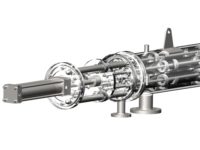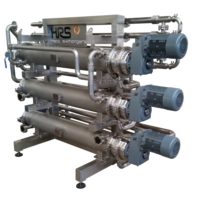The texture and viscosity of chilled food is not only an important quality parameter, but it also influences how it behaves during production and processing. Therefore, it should also influence the choice of equipment used in the manufacturing process. This is particularly true when this process has the potential to change the viscosity of the product itself, as can be the case with pasteurization or cooking.
Here’s a look at some of the key questions to ask when considering heat exchangers for food pasteurization.
Why pasteurize food?
Pasteurization is a heat treatment that reduces the presence of potentially harmful bacteria in certain foods to make them safe to eat and/or slow down spoilage and extend shelf life. Pasteurization differs from sterilization in that it only aims to reduce the number of bacterial pathogens to a level where they are very unlikely to cause disease before the specified use-by-date and potentially extend the shelf life of the product in question. For alkaline foods, it will typically extend shelf life by several days, while acidic foods (with a pH above 4.5) can often have their shelf life increased by months. In contrast, sterilization aims to kill all pathogens present in the food or drink to prevent spoilage for long periods.
What types of food are typically pasteurized?
Examples of foods typically pasteurized include egg products such as liquid and dried eggs, milk and dairy products, fruit juices and table and cooking sauces. Meat such as beef is also often surface pasteurized with steam, while some fresh produce, poultry and spices are treated with irradiation pasteurization.
What different types of pasteurization are there?
There are various different types of pasteurization based on different combinations of heat and time. Two of the most common are high-temperature, short-time (HTST), also known as flash pasteurization, which typically treats at high temperatures for between 3-15 seconds; and extended shelf life (ESL). Low-temperature, long-time (LTLT) treatments have a greater effect on nutrient and quality composition. Different techniques may be used for LTLT pasteurization, including heat exchangers and irradiation.
What is the “D-value” and why is it important?
When determining the factors required for effective pasteurization, there are two key variables to consider:
- The heat required to raise the temperature of the foodstuff by the right amount to destroy sufficient pathogens without changing other characteristics. This is known as the sensible heat.
- The timing (or extent) of heat treatment required to stabilize the foodstuff based on the most resistant enzyme or micro-organism present, the so-called “D value.”
Other elements that characterize the quality of food, including flavors, colors and vitamins also have their own D values, and it is often the case that using the HTST method will best preserve the quality of the foodstuff, but this is not always true.
Why are texture and viscosity important?
Viscosity is a measure of texture, which is itself one of the key quality characteristics of food and drink. As viscosity is a key component of the texture of food and drink, processing operations should not have an adverse effect on it. Factors such as pumping, heating, cooling and passing through pipe work all have the potential to affect viscosity, with the exact effects depending both on the liquid itself and the way it is handled.
How do you measure viscosity?
Viscosity is a measure of a substance’s resistance to motion under an applied force based on the amount of force required to remove one layer in relation to another (shear stress) and the change in speed of the layers relative to each other (the shear rate). It is measured in units called centipoise (cP) with one cP being equal to 1 mPa sec-1 (millipascal per second).
Most fluids are classified as being either Newtonian or non-Newtonian, based on the way their viscosity changes according to shear stress and temperature. Newtonian fluids have the same viscosity irrespective of changes or shear stress, the most common example of this is water. Non-Newtonian fluids (which are further divided into five categories) have viscosities that fluctuate depending on the shear rate applied.
Why does this matter?
Dairy products have a wide range of viscosity, from liquid milk, which has a value of 2.0 cP at 64°F, through 45% fat cream (48 cP) to yogurt (152 cP at 104°F) and cheese (30,000 cP). Consequently, while simple plate heat exchangers may be the most common solution for pasteurizing milk in the industry, adopting a “one-size-fits-all” approach may not be the best option for viscous products such as cream.
Using tubular heat exchangers can provide a number of benefits for viscous dairy products. The main advantage is the gentle handling that maintains the key viscosity characteristics of the product such as texture and mouthfeel. But, there are many other benefits from using tubular heat exchangers in the dairy sector. Innovations such as corrugated or scraped tubes help maintain flow and reduce fouling, improving cleaning-in-place procedures and reducing maintenance. Consequently, tubular heat exchangers feature improved service life, which is an important consideration when calculating return on investment.
A practical illustration
In a real-world example, a U.S. food company experienced a problem with the viscosity of pizza sauce (a non-Newtonian fluid) being manufactured for a restaurant chain. After cooking, the sauce was pumped through a multi-tube heat exchanger to cool it. However, the system pressure was so great that the generated shear stress on the sauce permanently changed its viscosity, making it thinner than it should be. In the worst cases, the sauce was so thin that that it would not stay on the pizza base when used in the restaurants.
The original heat exchanger being used passed the sauce though a series of half-inch and one-inch tubes, which generated high pressure. It was replaced with a different type of heat exchanger, which uses seven 3-inch tubes resolved the pressure issues. In addition, the new unit has an oscillating cleaning system, which is gentler than a rotary scraped surface heat exchanger, further helping to maintain the quality of the sauce.
Whatever foodstuff you are looking to heat or cool, understanding its viscosity properties is the first step to specifying a system that will not result in adverse effects on the quality of your product and choosing a heat exchanger of a suitable type and design.






